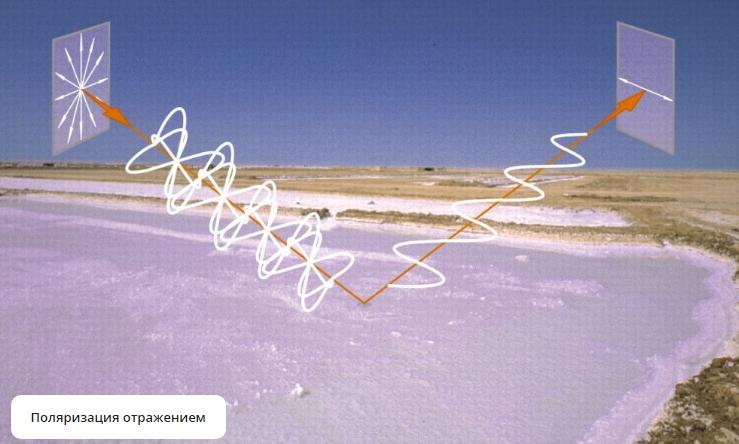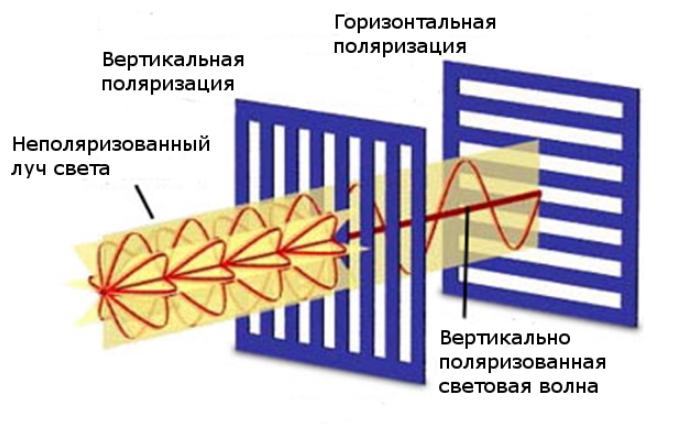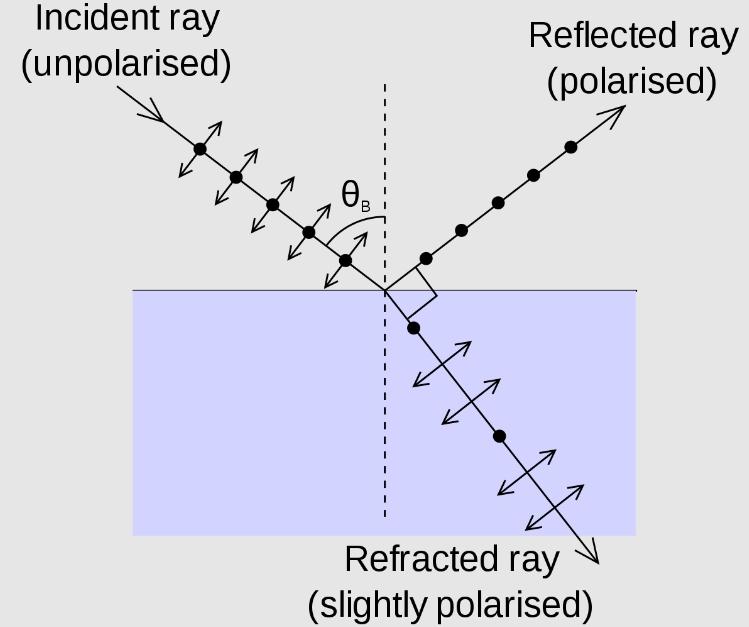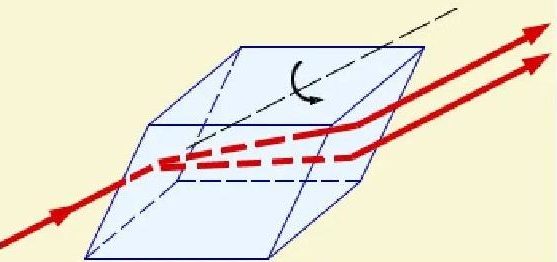What is light polarization and its practical application
Polarized light differs from standard light in its propagation. It was discovered quite a long time ago and is used both for physical experiments and in everyday life to perform some measurements. To understand the phenomenon of polarization is not difficult, it will allow to understand the principle of operation of some devices and find out why under certain conditions the light does not spread as it normally does.

What is light polarization
The polarization of light proves that light is a transverse wave. That is, we are talking about the polarization of electromagnetic waves in general, and light is one of the varieties, the properties of which are subject to general rules.
Polarization is the property of transverse waves whose vector of oscillation is always perpendicular to the direction of propagation of light or something else. That is, if you isolate rays of light with the same polarization vector, it will be the phenomenon of polarization.
Most often we see non-polarized light around us, because its intensity vector moves in all possible directions. To make it polarized, we pass it through an anisotropic medium, which cuts off all vibrations and leaves only one.

Who discovered the phenomenon and what it proves
The concept in question was first used by the famous British scientist И. Newton in 1706.. But its nature was explained by another researcher. James Maxwell.. At that time, the nature of light waves was not known, but as various facts and results of various experiments accumulated, more and more evidence for the transverse nature of electromagnetic waves appeared.
The first to experiment in this area was the Dutch explorer Huygens, in 1690.. He passed light through a plate of Icelandic feldspar, as a result of which he discovered transverse anisotropy of the beam.
The first proof of the polarization of light in physics was obtained by the French researcher Э. Malus. He used two plates of tourmaline and eventually derived the law named after him. Through numerous experiments, the transverse nature of light waves was proven, which helped to explain their nature and peculiarities of propagation.
Where does the polarization of light come from and how to get it yourself
Most of the light we see is not polarized. Sun, artificial light - light with a vector oscillating in different directions spreads in all directions without any limitation.
Polarized light appears after it has passed through an anisotropic medium, which may have different properties. This medium removes most of the vibrations, leaving only one, which provides the desired effect.
Most often crystals act as a polarizer. While in the past mostly natural materials (e.g. tourmaline) were used, now there are many variants of artificial origin.
Also polarized light can be obtained by reflection from any dielectric. The idea is that when a light flux at the junction of the two media, it's refracted. This can easily be seen by placing a pencil or tube in a glass of water.

In the phenomenon of light refraction, some of the rays are polarized. The extent of this effect depends on the location light source and the angle of incidence of the light in relation to the place of refraction.
Regarding the ways of obtaining polarized light, one of three options is used, regardless of the conditions:
- Nicolas prism.. Named after the Scottish explorer Nicolas William, who invented it in 1828. He experimented for a long time and after 11 years was able to obtain a finished device, which is still in use today in its unchanged form.
- Reflection from a dielectric. Here it is very important to find the optimum angle of incidence and to consider the degree of of refraction (The greater the difference in transmittance of the two media, the more the rays are refracted).
- Using an anisotropic medium. Most often crystals with suitable properties are selected for this purpose. If the light flux is directed at them, a parallel separation can be observed at the output.
Polarization of light by reflection and refraction at the interface of two dielectrics
This optical phenomenon was discovered by Scottish physicist ...by David Brewster in 1815.... The law he derived showed the relationship between the indices of the two dielectrics at a certain angle of incidence of light. If the conditions are chosen, the rays reflected from the interface of the two media will be polarized in the plane perpendicular to the angle of incidence.

The researcher noted that the refracted beam is partially polarized in the plane of incidence as well. Not all of the light is reflected, some of it goes into the refracted beam. The Brewster angle is the angle at which reflected light is completely polarized. The reflected and refracted rays are perpendicular to each other.
To understand the reason for this phenomenon, we need to know the following:
- In any electromagnetic wave, the vibrations of the electric field are always perpendicular to the direction of its motion.
- The process is divided into two stages. In the first, the incident wave causes the dielectric molecules to agitate; in the second, there are refracted and reflected waves.
If you use a single plate of quartz or other suitable mineral in the experiment, the intensity of plane-polarized light will be small (on the order of 4% of the total intensity). But if you use a stack of plates, you can achieve a significant increase in performance.
By the way! Brewster's law can also be derived using Fresnel formulas.
Polarization of light by a crystal
Ordinary dielectrics are anisotropic and the characteristics of light striking them depend mainly on the angle of incidence. Crystals have different properties; when light falls on them, the effect of double refraction of rays can be observed. This manifests itself as follows: when passing through the structure, two refracted rays are formed, which go in different directions, their velocities are also different.
Most often uniaxial crystals are used in experiments. One of the refraction beams in them obeys standard laws and is called ordinary. The second beam is formed differently, it is called extraordinary, because the peculiarities of its refraction do not correspond to the usual canons.

If you rotate the crystal, the ordinary beam will remain unchanged, while the extraordinary beam will move around the circumference. Calcite or Icelandic feldspar are most often used in experiments because they are well suited for research.
By the way! If you look at your surroundings through the crystal, the outlines of all objects will bifurcate.
Based on experiments with crystals. Etienne Louis Malus formulated a law in 1810 in 1810, which is named after him. He derived a clear relationship of linearly polarized light after it passes through a polarizer made from crystals. The intensity of the beam after passing through the crystal decreases in proportion to the square of the cosine of the angle formed between the polarization plane of the incoming beam and the filter.
Video lesson: Polarization of light, grade 11 physics.
Practical applications of light polarization
The phenomenon in question is used in everyday life much more often than it seems. Knowledge of the laws of propagation of electromagnetic waves has helped in the creation of various equipment. The main options are as follows:
- Special polarizing filters for cameras allow you to get rid of glare when taking pictures.
- Glasses with this effect are often used by drivers, as they remove glare from the headlights of oncoming traffic. As a result, even the high beam cannot dazzle the driver, which increases safety.The absence of glare is due to the polarization effect.
- Equipment used in geophysics allows you to study the properties of cloud masses. It is also used to study the peculiarities of polarization of sunlight as it passes through clouds.
- Special installations that photograph space nebulae in polarized light help to study the peculiarities of the magnetic fields arising there.
- The so-called photoelastic method is used in mechanical engineering. With its help, you can clearly determine the parameters of stresses occurring in nodes and parts.
- The equipment is used in the creation of theatrical scenery as well as in concert decorations. Another sphere of application is showcases and exhibition stands.
- Devices which determine a person's blood sugar level. They work by determining the angle of rotation of the polarization plane.
- Many enterprises in the food industry use equipment capable of determining the concentration of a particular solution. There are also devices that can monitor proteins, sugars and organic acids through the use of polarization properties.
- 3D cinematography works precisely through the use of the phenomenon discussed in this article.
By the way! Familiar liquid crystal monitors and televisions also work based on polarized flux.
Knowledge of the basic features of polarization allows us to explain many effects that occur around us. Also this phenomenon is widely used in science, technology, medicine, photography, cinematography and many other fields.
